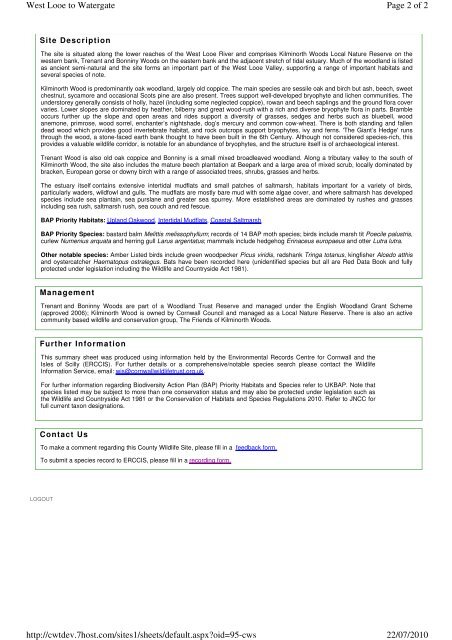County Wildife Site Criteria for Cornwall Appendices
County Wildife Site Criteria for Cornwall Appendices
County Wildife Site Criteria for Cornwall Appendices
Create successful ePaper yourself
Turn your PDF publications into a flip-book with our unique Google optimized e-Paper software.
West Looe to Watergatehttp://cwtdev.7host.com/sites1/sheets/default.aspx?oid=95-cwsPage 2 of 222/07/2010<strong>Site</strong> DescriptionThe site is situated along the lower reaches of the West Looe River and comprises Kilminorth Woods Local Nature Reserve on thewestern bank, Trenant and Bonniny Woods on the eastern bank and the adjacent stretch of tidal estuary. Much of the woodland is listedas ancient semi-natural and the site <strong>for</strong>ms an important part of the West Looe Valley, supporting a range of important habitats andseveral species of note.Kilminorth Wood is predominantly oak woodland, largely old coppice. The main species are sessile oak and birch but ash, beech, sweetchestnut, sycamore and occasional Scots pine are also present. Trees support well-developed bryophyte and lichen communities. Theunderstorey generally consists of holly, hazel (including some neglected coppice), rowan and beech saplings and the ground flora covervaries. Lower slopes are dominated by heather, bilberry and great wood-rush with a rich and diverse bryophyte flora in parts. Brambleoccurs further up the slope and open areas and rides support a diversity of grasses, sedges and herbs such as bluebell, woodanemone, primrose, wood sorrel, enchanter’s nightshade, dog’s mercury and common cow-wheat. There is both standing and fallendead wood which provides good invertebrate habitat, and rock outcrops support bryophytes, ivy and ferns. 'The Giant’s Hedge' runsthrough the wood, a stone-faced earth bank thought to have been built in the 6th Century. Although not considered species-rich, thisprovides a valuable wildlife corridor, is notable <strong>for</strong> an abundance of bryophytes, and the structure itself is of archaeological interest.Trenant Wood is also old oak coppice and Bonniny is a small mixed broadleaved woodland. Along a tributary valley to the south ofKilminorth Wood, the site also includes the mature beech plantation at Beepark and a large area of mixed scrub, locally dominated bybracken, European gorse or downy birch with a range of associated trees, shrubs, grasses and herbs.The estuary itself contains extensive intertidal mudflats and small patches of saltmarsh, habitats important <strong>for</strong> a variety of birds,particularly waders, wildfowl and gulls. The mudflats are mostly bare mud with some algae cover, and where saltmarsh has developedspecies include sea plantain, sea purslane and greater sea spurrey. More established areas are dominated by rushes and grassesincluding sea rush, saltmarsh rush, sea couch and red fescue.BAP Priority Habitats: Upland Oakwood, Intertidal Mudflats, Coastal SaltmarshBAP Priority Species: bastard balm Melittis melissophyllum; records of 14 BAP moth species; birds include marsh tit Poecile palustris,curlew Numenius arquata and herring gull Larus argentatus; mammals include hedgehog Erinaceus europaeus and otter Lutra lutra.Other notable species: Amber Listed birds include green woodpecker Picus viridis, redshank Tringa totanus, kingfisher Alcedo atthisand oystercatcher Haematopus ostralegus. Bats have been recorded here (unidentified species but all are Red Data Book and fullyprotected under legislation including the Wildlife and Countryside Act 1981).ManagementTrenant and Boninny Woods are part of a Woodland Trust Reserve and managed under the English Woodland Grant Scheme(approved 2006); Kilminorth Wood is owned by <strong>Cornwall</strong> Council and managed as a Local Nature Reserve. There is also an activecommunity based wildlife and conservation group, The Friends of Kilminorth Woods.Further In<strong>for</strong>mationThis summary sheet was produced using in<strong>for</strong>mation held by the Environmental Records Centre <strong>for</strong> <strong>Cornwall</strong> and theIsles of Scilly (ERCCIS). For further details or a comprehensive/notable species search please contact the WildlifeIn<strong>for</strong>mation Service, email: wis@cornwallwildlifetrust.org.uk.For further in<strong>for</strong>mation regarding Biodiversity Action Plan (BAP) Priority Habitats and Species refer to UKBAP. Note thatspecies listed may be subject to more than one conservation status and may also be protected under legislation such asthe Wildlife and Countryside Act 1981 or the Conservation of Habitats and Species Regulations 2010. Refer to JNCC <strong>for</strong>full current taxon designations.Contact UsTo make a comment regarding this <strong>County</strong> Wildlife <strong>Site</strong>, please fill in a feedback <strong>for</strong>m.To submit a species record to ERCCIS, please fill in a recording <strong>for</strong>m.LOGOUT
















